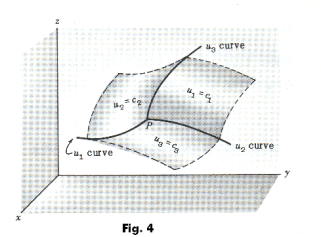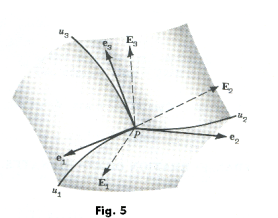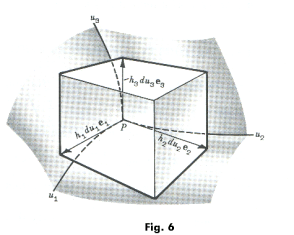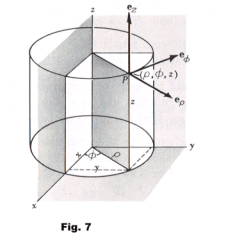Website owner: James Miller
CURVILINEAR COORDINATES
Def. Reciprocal sets of vectors. The sets of vectors a, b, c and a', b', c' are called reciprocal sets or systems of vectors if
1) a∙a' = b∙b' = c∙c' = 1
2) a'∙b = a'∙c = b'∙a = b'∙c = c'∙a = c'∙b = 0
Theorem. The sets a, b, c and a', b', c' are reciprocal sets if and only if
![]()
From condition 2) we see that a' is perpendicular to b and c, b' is perpendicular to a and c, and c' is perpendicular to a and b. However, the vectors a, b, c need not be perpendicular to each other.
Example. The sets
a = (2, 3, -1), b = (1, -1 -2), c = (-1, 2, 2)
and
a' = (2/3, 0, 1/3), b' = (-8/3, 1, -7/3), c' = (-7/3, 1, -5/3)
are reciprocal sets of vectors.
The concept of reciprocal sets of vectors comes into play in the unit base vectors e1, e2, e3 and E1, E2, E3 of curvilinear coordinate systems as discussed below under Curvilinear trihedrals.
____________________________________________________________________________
Coordinate transformations. Many problems in physics and elsewhere can be more easily and naturally formulated, analyzed and solved in some non-rectangular coordinate system such as a cylindrical or spherical coordinate system than they can in the usual rectangular Cartesian coordinate system. When using different coordinate systems we often wish to convert coordinates from one system to another. We do this using transformation equations which relate the coordinates of a general point P as referred to the two coordinate systems. For coordinate transformations in three dimensional space these transformation equations have the general form
u1 = u1(x, y, z)
1) u2 = u2(x, y, z)
u3 = u3(x, y, z)
along with an inverse transformation
x = x(u1, u2, u3)
2) y = y(u1, u2, u3)
z = z(u1, u2, u3) .
For example, cylindrical coordinates are related to rectangular coordinates by the transformation

and the inverse transformation
x = r cos θ
y = r sin θ
z = z
where r, θ, and z correspond to the u1, u2, and u3 of systems 1) and 2).
A general characteristic of a system of equations of type 1) above that is being used in this way --- i.e. used to relate the coordinates of some general point P in space as referred two different coordinate systems — is that it represents a one-to-one mapping over that domain on which it will be used and thus possesses an inverse on that domain.
The various non-rectangular coordinate systems have given rise to a generalization of the concept of a coordinate system in the idea of a generalized (curvilinear) coordinate system employing curvilinear coordinates as follows.
Curvilinear coordinates. Consider the system of equations
3) u = u(x, y)
v = v(x, y) .
This system can be viewed as a function that assigns a number pair (u, v) to each number pair (x, y). Let us suppose that the system effects a one-to-one mapping over some region R of the xy-plane, mapping region R into region R' of the uv-plane. This will be the case if the transformation is continuously differentiable and the Jacobian does not vanish at any point within region R. In this case this system of equations associates a unique pair of numbers (u, v) to each number pair (x, y) in region R. If a point P0 has coordinates (x0, y0) in the xy-plane transformation 3) associates with point P0 the number pair (u0, v0). Why can we not use (u0, v0) as the coordinates of point P0? Why can we not regard system 3) as defining a transformation between the x-y coordinate system and some other unknown coordinate system (a coordinate system whose nature and characteristics we don’t know) and refer to point P by its coordinates in that system? This is the idea underlying a generalized (curvilinear) coordinate system. An important stipulation on the use of this idea, however, is that it can only be used in a region where the mapping is one-to-one. Depending on the defining equations 3), the domain of the mapping might be the entire xy-plane or it might be necessary to limit the domain to a relatively small region in the plane or even just the immediate neighborhood of some selected point. The domain must be chosen in such a way so as to avoid any points where the Jacobian vanishes. For insight into the type of situation one may encounter consider the following question
Question. Given some selected point (u0, v0) in the uv-plane, what points in the xy-plane will map into it?
Answer. Assume the loci of the equations
u(x, y) = u0
v(x, y) = v0

are those shown in Fig. 1. Then the function u(x, y) maps all points on the locus of u(x, y) = u0 into the number u0. Similarly, the function v(x, y) maps all points on the locus of v(x, y) = v0 into the number v0. Thus all points of intersection of the curves u(x, y) = u0 and v(x, y) = v0 map into the point (u0, v0) in the uv-plane. We see in the figure that four points in the xy-plane map into the single point (u0, v0) in the uv-plane. Obviously the domain for our mapping in this case cannot be chosen as the entire xy-plane. One could, however, choose some point, such as the point P shown in the figure, and then use as the domain of the mapping a relatively small region in the vicinity of P. Within this relatively small region one could employ curvilinear coordinates.
u-curves and v-curves. Let us now suppose that the mapping 3) effects a one-to-one mapping over some region R of the xy-plane, mapping region R into region R' of the uv-plane and that the inverse transformation is given by
4)x = x(u, v)
y = y(u, v) .
If we regard u as fixed in system 4) i.e. u = c1, a constant, then system 4) becomes a system in a single variable v describing a curve where v is the varying parameter. For each different value of u there is a separate curve. These curves are called v-curves. Similarly one can let v = c2, a constant, and obtain a u-curve where u is the varying parameter. One thus obtains families of u-curves and v-curves. The u-curves and v-curves are called coordinate curves. These coordinate

curves form a curvilinear net on the surface similar to the coordinate net on a plane.
Fig. 2 shows a mesh of quadrilaterals formed by the u-curves and v-curves in the xy-plane by a parameterization of u and v in the immediate vicinity of a point of interest P. The u-curves and v-curves map into mutually perpendicular lines in the uv-plane. Points on the v-curve u(x, y) = c1 map into the line u = c1 and points on the u-curve v(x, y) = c2 map into the line v = c2.
Curvilinear coordinates of a point on a surface in 3-space. Let S be a surface element defined by the one-to-one mapping
x = x(u, v)
5) y = y(u, v)
z = z(u, v)

of a region R of the uv-plane into xyz-space. The parametric equations 5) assign a point (x, y, z) to each number pair (u, v). The number pair (u, v) can be considered a set of coordinates for a point P(x, y, z). The numbers (u, v) are called the curvilinear coordinates of point P. If we regard u as fixed in system 5) i.e. u = c, a constant, then system 5) becomes a system in a single variable v describing a space curve where v is the varying parameter. For each different value of u there is a separate space curve. These curves are called v-curves. Similarly one can let v = k, a constant, and obtain a u-curve where u is the varying parameter. One thus obtains families of u-curves and v-curves. The u-curves and v-curves are called coordinate curves. These coordinate curves form a curvilinear net on the surface similar to the coordinate net on a plane. See Fig. 3.
Curvilinear coordinates for a 3-space to 3-space mapping. Let us now consider the one-to-one mapping
x = x(u1, u2, u3)
6) y = y(u1, u2, u3)
z = z(u1, u2, u3)
defined over some region R of u1-u2-u3 space, mapping R into region R' in xyz-space. Let the inverse transformation be
u1 = u1(x, y, z)
7) u2 = u2(x, y, z)
u3 = u3(x, y, z) .
Region R might be all of u1-u2-u3 space or only some small, localized region. Within region R the mapping is continuously differentiable and the Jacobian is nonvanishing.
The parametric equations 6) assign a point (x, y, z) to each number triple (u1, u2, u3). The number triple (u1, u2, u3) can be considered a set of coordinates for a point P(x, y, z). The numbers (u1, u2, u3) are called the curvilinear coordinates of point P.

The three surfaces
u1(x, y, z) = c1
u2(x, y, z) = c2
u3(x, y, z) = c3
where c1, c2, c3 are constants, are called coordinate surfaces and each pair of these surfaces intersect in curves called coordinate curves. See Fig. 4. Each of the three surfaces represents one of a family of surfaces generated by different values of the parameter ci (constant term). The family corresponding to u1(x, y, z) = c1 are called the u1 surfaces, the family corresponding to u2(x, y, z) = c2 are called the u2 surfaces, etc. The curve corresponding to the intersection of a u1 surface with a u2 surface is called a u3-curve (it is also sometimes called a u1u2-curve, depending on the author). See Fig. 3. Similarly for the other coordinate curves.
If we regard u2 and u3 as fixed in system 6) i.e. u2 = c2, u3 = c3, then 6) becomes a system in a single variable u1 describing a space curve where u1 is the varying parameter, namely the u1-curve. If we regard u1 and u3 as fixed in system 6) i.e. u1 = c1, u3 = c3, then 6) becomes a system in a single variable u2 describing a space curve where u2 is the varying parameter, namely the u2-curve. Similarly for the u3-curves.
The u1, u2, and u3 coordinate curves of a curvilinear system correspond to the x, y and z axes of a rectangular system. Since the three coordinate curves are generally not straight lines, as in the rectangular coordinate system, such coordinate systems are called curvilinear coordinate systems.

Curvilinear trihedrals. In a rectangular Cartesian coordinate system we have the base vectors i, j, k which are unit vectors in the directions of the x, y and z axes. We can introduce a similar set of unit base vectors for curvilinear coordinate systems. In fact, we introduce two sets. The first set is the set of unit vectors e1, e2, e3 tangent at P to the coordinate curves through P. The second set is the set of unit vectors E1, E2, E3 normal at P to the coordinate surfaces through P. See Fig. 5. Both sets are analogous to the i, j, k unit vectors in rectangular coordinates but are unlike them in that they may change direction from point to point. It can be shown that the two sets, e1, e2, e3 and E1, E2, E3, represent reciprocal systems of vectors.
Expressions for the unit base vectors e1, e2, e3 and E1, E2, E3. Let r = x i + y j + z k be a position vector of a point P. Then, from 5),
r = x(u1, u2, u3) i + y(u1, u2, u3) j + z(u1, u2, u3) k .
● The three unit vectors e1, e2, e3 tangent to the u1, u2, and u3 coordinate curves are given by

where

The quantities h1, h2 and h3 are called scale factors. The unit vectors e1, e2, e3 are in the directions of increasing u1, u2, u3, respectively.
● The three unit vectors E1, E2, E3 normal to the u1, u2, and u3 coordinate surfaces are given by

where
![]()
Vector representation in terms of base vectors. A vector A can be represented in terms of the unit base vectors e1, e2, e3 or E1, E2, E3 in the form
A = A1e1 + A2e3 + A3e3 = a1E1 + a2E3 + a3E3
where A1, A2, A3 and a1, a2, a3 are the respective components of A in each system.
We can also represent A in terms of the base vectors

which are called unitary base vectors but are not unit vectors, in general. In this case

and
![]()
where

C1, C2, C3 are called the contravariant components of A and c1, c2, c3 are called the covariant components of A.
____________________________________________________________________________
Orthogonal curvilinear coordinates. A curvilinear coordinate system is called orthogonal if the coordinate curves are everywhere orthogonal. In this case, the three vectors e1, e2, e3 are mutually orthogonal at every point i.e.
e1•e2 = e2•e3 = e3•e1 = 0 .
We shall also assume that e1, e2, e3 form a right handed system.
● In an orthogonal curvilinear coordinate system the base vectors e1, e2, e3 and E1, E2, E3 become identical i.e.
e1 = E1, e2 = E2, e3 = E3 .
● In an orthogonal curvilinear coordinate system the following hold:

![]()
![]()
Arc length and volume elements in orthogonal systems. From
r = x(u1, u2, u3) i + y(u1, u2, u3) j + z(u1, u2, u3) k
we obtain

The differential of arc length ds is determined from ds2 = dr•dr. For orthogonal systems, e1•e2 = e2•e3 = e3•e1 = 0 and

ds2 = h12 du12 + h22 du22 + h32 du32
Along a u1 curve, u2 and u3 are constants so dr = h1 du1 e1. Thus the differential of arc length ds1 along u1 at P is h1 du1 and the differential arc lengths along u2 and u3 are ds2 = h2 du2 and ds3 = h3 du3.
Thus, referring to Fig. 6, the volume element for an orthogonal curvilinear coordinate system is given by
![]()
Expressions for the gradient, divergence and curl in terms of curvilinear coordinates in orthogonal systems. If Φ is a scalar function and A = A1e1 + A2e3 + A3e3 is a vector function of orthogonal curvilinear coordinates u1, u2, u3 then the following hold.



![]()

Special orthogonal curvilinear coordinate systems. The following are examples of some orthogonal curvilinear coordinate systems.
1. Cylindrical coordinates
2. Spherical coordinates
3. Parabolic cylindrical coordinates
4. Parabolic coordinates
5. Elliptic cylindrical coordinates
6. Prolate spheroidal coordinates
7. Oblate spheroidal coordinates
8. Ellipsoidal coordinates
9. Bipolar coordinates




See Murray R. Spiegel. Vector Analysis. (Schaum) for more information on different coordinate systems.
References.
Spiegel. Vector Analysis. Chap. 7.
Hsu. Vector Analysis.
Taylor. Advanced Calculus.
Jesus Christ and His Teachings
Way of enlightenment, wisdom, and understanding
America, a corrupt, depraved, shameless country
On integrity and the lack of it
The test of a person's Christianity is what he is
Ninety five percent of the problems that most people have come from personal foolishness
Liberalism, socialism and the modern welfare state
The desire to harm, a motivation for conduct
On Self-sufficient Country Living, Homesteading
Topically Arranged Proverbs, Precepts, Quotations. Common Sayings. Poor Richard's Almanac.
Theory on the Formation of Character
People are like radio tuners --- they pick out and listen to one wavelength and ignore the rest
Cause of Character Traits --- According to Aristotle
We are what we eat --- living under the discipline of a diet
Avoiding problems and trouble in life
Role of habit in formation of character
Personal attributes of the true Christian
What determines a person's character?
Love of God and love of virtue are closely united
Intellectual disparities among people and the power in good habits
Tools of Satan. Tactics and Tricks used by the Devil.
The Natural Way -- The Unnatural Way
Wisdom, Reason and Virtue are closely related
Knowledge is one thing, wisdom is another
My views on Christianity in America
The most important thing in life is understanding
We are all examples --- for good or for bad
Television --- spiritual poison
The Prime Mover that decides "What We Are"
Where do our outlooks, attitudes and values come from?
Sin is serious business. The punishment for it is real. Hell is real.
Self-imposed discipline and regimentation
Achieving happiness in life --- a matter of the right strategies
Self-control, self-restraint, self-discipline basic to so much in life